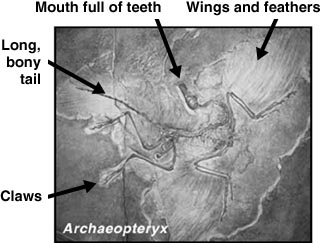
In order to explore the evolution of flight, we will look at the fossil record and interpret the evidence that we find. The following story illustrates the kinds of evidence we will be using.
Suppose that you hear a crash in the kitchen. You walk inside and find broken glass and a puddle of clear liquid that were not there only moments before. The glass and puddle are direct evidence of what happened. What might you infer? What probably happened?
Now let’s see how we can use direct evidence from fossils to make inferences about past life.
Class discussion or written assignment:
Examine the Archaeopteryx fossil with a partner. Then respond to the questions below.
a. The fossil itself is direct evidence that Archaeopteryx existed. But look closely; there is more information to be gained from the evidence. Look at the features shown in this fossil.
b. We can make inferences about how Archaeopteryx behaved, based upon these features. What inference, or hypothesis, can you make about its behavior based upon the evidence? (HINT: its claws, teeth, wings and feathers?)
c. Paleontologists often make comparisons with living animals to learn more about extinct animals. Using living animals, give an example that might support your hypothesis about Archaeopteryx.
